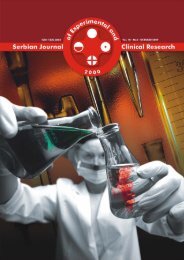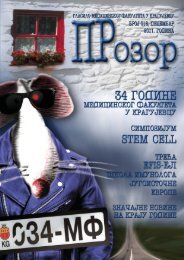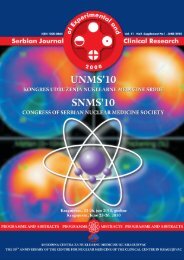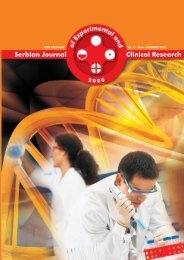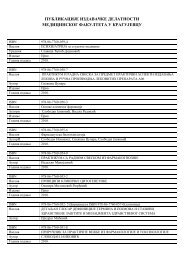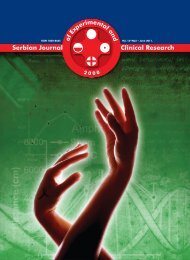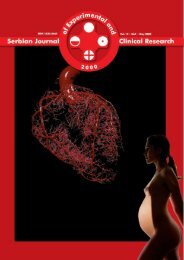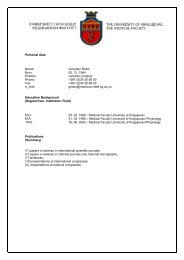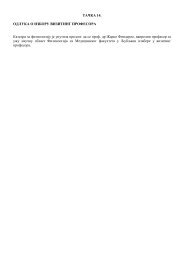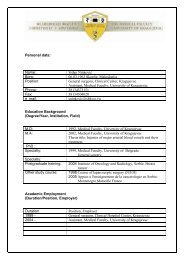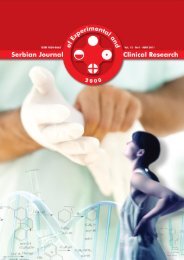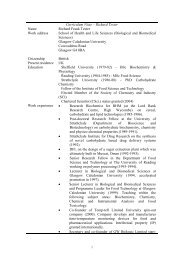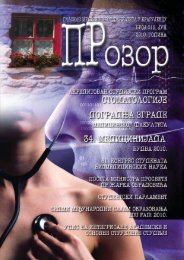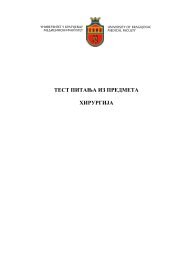Untitled - Medicinski fakultet Kragujevac - Univerzitet u Kragujevcu
Untitled - Medicinski fakultet Kragujevac - Univerzitet u Kragujevcu
Untitled - Medicinski fakultet Kragujevac - Univerzitet u Kragujevcu
You also want an ePaper? Increase the reach of your titles
YUMPU automatically turns print PDFs into web optimized ePapers that Google loves.
DISCUSSION<br />
In this study, we report that 12 days after the inoculation<br />
of 4T1 mammary carcinoma cells, the percentage<br />
and number of CD19 + B cells in spleens were significantly<br />
increased, while the number and cytotoxic activity of NK<br />
cells were decreased (Fig. 1). Additionally, the frequency<br />
and number of CD11c + dendritic cells were higher in<br />
spleens from tumour-bearing mice compared with naïve<br />
mice, but the frequency of activated dendritic cells in both<br />
groups was not significantly different (Fig. 3).<br />
The increased frequency and number of CD19 + B cells<br />
in spleens of tumour-bearing BALB/c mice could be the<br />
result of Th2 polarisation, which implicates the predominance<br />
of the type-2 antitumor immune response (22).<br />
However, there is evidence that the type-17 response can<br />
also induce B cell proliferation and the formation of germinal<br />
centres (47). Several studies have shown that B cell<br />
proliferation in lymph organs correlates with tumour progression<br />
(48-49). Furthermore, we found no difference in<br />
the percentage or number of splenic T cells and CD4 + and<br />
CD8 + subpopulations, indicating weak or no activity of<br />
adaptive cellular immunity, on day 12 after tumour challenge<br />
(Fig 1).<br />
We also detected the decreased cytotoxicity of total<br />
splenocytes isolated from tumour-bearing mice (Fig. 2).<br />
To determine which cell population was responsible for<br />
this phenomenon, we isolated NK and CD8 + T cells and<br />
tested their antitumor cytotoxic activity in vitro at day 12.<br />
We found enhanced cytotoxicity of CD8 + T cells (Fig. 2).<br />
However, the cytotoxic activity of NK cells was significantly<br />
decreased at the same time point, which contributed<br />
to the lower cytotoxic activity of total splenocytes<br />
(Fig. 2). During the cytotoxic killing of tumour cells, NK<br />
cells and CD8 + T cells rapidly release granules containing<br />
perforin and granzymes into the immunological synapse,<br />
thereby inducing the death of target cells (50). Lysosomalassociated<br />
membrane protein-1 (LAMP-1), also known as<br />
CD107a, is a marker of cytotoxic degranulation, as it lines<br />
the membrane of these granules (51). CD107a can be used<br />
as an indirect indicator of the cytotoxic capacity of NK and<br />
CD8 + T cells (52). In line with these findings, we found a<br />
higher frequency of activated CD8 + CD107a + T cells while<br />
activated NKp46 + CD107a + NK cells were less frequent in<br />
spleens from tumour-bearing mice (Fig. 2). Several studies<br />
have revealed lower cytotoxic activity of NK cells in patients<br />
with breast cancer compared with healthy controls,<br />
with a negative correlation of NK cell lytic activity with<br />
lymph node progression of disease (9).<br />
Functional maturation and the activity of NK and T<br />
cells appear to be dependent on the functional phenotype<br />
of DCs (53). We showed that tumour inoculation led to an<br />
increase in the frequencies and numbers of CD11c + DCs<br />
in spleens (Fig. 3). During maturation/activation, DCs express<br />
more MHC class II and CD80 and CD86 co-stimulatory<br />
molecules, all of which have T-cell stimulatory capacity.<br />
However, there was no difference in the percentage<br />
or total number of fully functional CD80 + CD86 + DCs in<br />
tumour-bearing mice compared with healthy animals (Fig.<br />
3). Thus, it could be assumed that 12 days after tumour inoculation,<br />
the functional maturation of dendritic cells was<br />
absent. The interaction of mature DCs with NK and T cells<br />
is essential for the tumoricidal activity of these effector<br />
cells, while immature DCs can induce immunosuppressive<br />
activity of the same effector cells (34-35).<br />
Taken together, we demonstrate that 12 days after inoculation<br />
with 4T1 mammary breast carcinoma, NK cell<br />
cytotoxicity was markedly reduced, and DCs were not activated<br />
after tumour challenge. These findings suggest a<br />
suppressed innate anti-tumour immune response in mammary<br />
carcinoma-bearing BALB/c mice.<br />
ACKNOWLEDGEMENTS<br />
We thank Milan Milojevic for excellent technical assistance.<br />
This work was funded by grants from the Serbian<br />
Ministry of Science and Technological Development, Serbia<br />
(Grants OP 175071 and OP 175069) and by the Medical<br />
Faculty, University of <strong>Kragujevac</strong>, Serbia (Grant JP 25/10).<br />
REFERENCES<br />
1. Ferlay J, Parkin DM, Sreliarova-Foucher E. Estimates of<br />
cancer incidence and mortality in Europe in 2008. Eur J<br />
Cancer 2010; 46: 765-781.<br />
2. Lu X, Kang Y. Organotropism of breast cancer metastasis.<br />
J Mammary Gland Biol Neoplasia 2007; 12: 153-162.<br />
3. Vujanovic NL, Basse P, Herberman RB and Whiteside<br />
TL. Antitumor functions of natural killer cells and control<br />
of metastasis. Methods 1996; 9: 394-408.<br />
4. Standish LJ, Sweet ES, Novack J, Wenner CA, Bridge C,<br />
Nelson A, Martzen M, Torkelson C. Breast cancer and the<br />
immune system. J Soc Integr Oncol 2008; 6: 158-168.<br />
5. Riccardi C, Santoni A, Barlozzari T, Puccetti P, Herberman<br />
RB. In vivo natural reactivity of mice against tumor<br />
cells. Int J Cancer 1980; 25: 475-486.<br />
6. Wiltrout RH, Herberman RB, Zhang SR, Chirigos MA, Ortaldo<br />
JR, Green KM Jr, Talmadge JE. Role of organ-associated<br />
NK cells in decreased formation of experimental metastases<br />
in lung and liver. J Immunol 1985; 134: 4267-4275.<br />
7. Gorelik E, Herberman RB. Radioisotope assay for evaluation<br />
of in vivo natural cell-mediated resistance of<br />
mice to local transplantation of tumor cells. Int J Cancer<br />
1981; 27: 709-720.<br />
8. Gorelik E, Wiltrout RH, Okumura K, Habu S, Herberman<br />
RB. Role of NK cells in the control of metastatic<br />
spread and growth of tumor cells in mice. Int J Cancer<br />
1982; 30: 107-112.<br />
9. Strayer DR, Carter WA, Mayberry SD et al. Low natural<br />
cytotoxicity of peripheral blood mononuclear cells<br />
in individuals with high familial incidences of cancer.<br />
Cancer Res 1984; 44: 370-374.<br />
59



